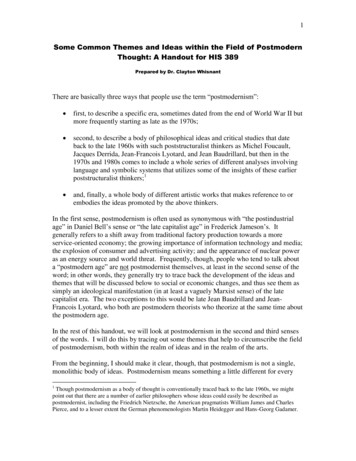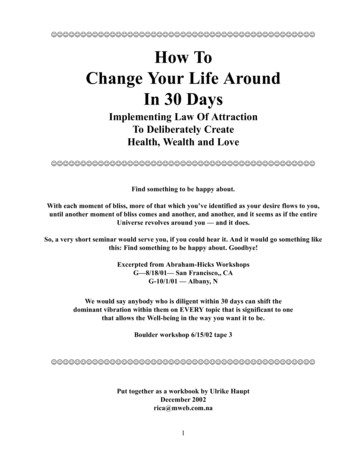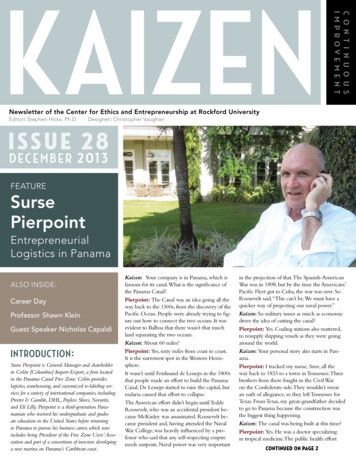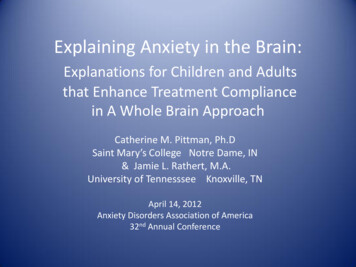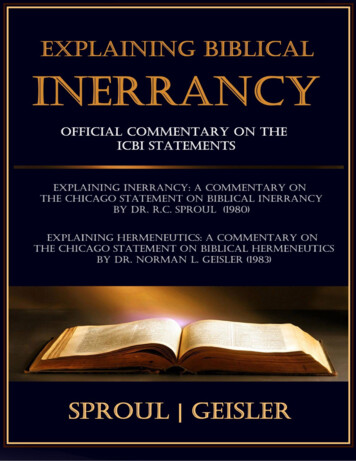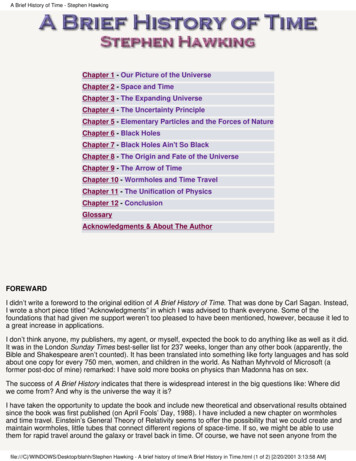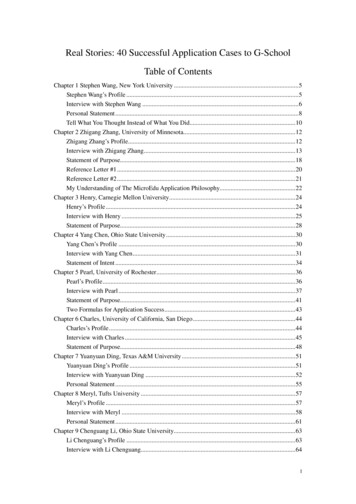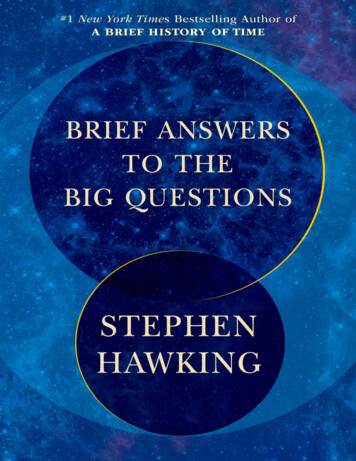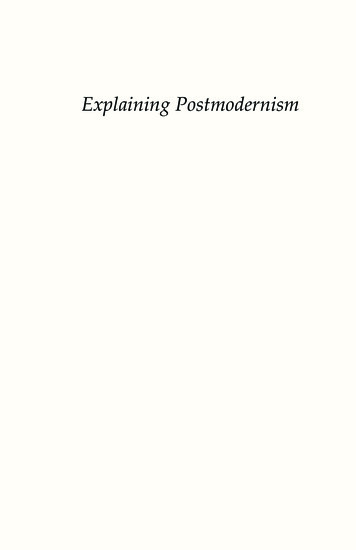
Transcription
Explaining Postmodernism
Explaining PostmodernismSkepticism and Socialism fromRousseau to FoucaultExpanded EditionStephen R. C. HicksOckham’s Razor Publishing
First Edition published in 2004 by Scholargy PublishingExpanded Edition published in 2011 by Ockham’s Razor Publishing 2004, 2011, 2014 by Stephen R. C. HicksAll rights reserved14 15 16Expanded Edition9 8 7 6 5 4 3 2 1Second PrintingTenth Anniversary PrintingLibrary of Congress Cataloging-in-Publication Data pendingHicks, Stephen R. C., 1960Explaining postmodernism: skepticism and socialism from Rousseau toFoucault / Stephen Hicks.p. 276cm.Includes bibliographic references.Includes index.ISBN: 978-0-9832584-0-7 (cloth)ISBN:(paper)1. Title. 2. Intellectual History—Modern. 3. Socialism—History. 4.United States— Intellectual Life—20th century. 5. Education, Higher—Political aspects. 6. Art—HistoryPrinted in ChinaThis book is printed on acid-free paper
ContentsThesis: The failure of epistemology made postmodernism possible, and the failureof socialism made postmodernism necessary.List of Tables and ChartsvChapter One: What Postmodernism IsThe postmodern vanguardFoucault, Lyotard, Derrida, RortyModern and postmodernModernism and the EnlightenmentPostmodernism versus the EnlightenmentPostmodern academic themesPostmodern cultural themesWhy postmodernism?15714151820Chapter Two: The Counter-Enlightenment Attack onReasonEnlightenment reason, liberalism, and scienceThe beginnings of the Counter-EnlightenmentKant’s skeptical conclusionKant’s problematic from empiricism and rationalismKant’s essential argumentIdentifying Kant’s key assumptionsWhy Kant is the turning pointAfter Kant: reality or reason but not bothMetaphysical solutions to Kant: from Hegel to NietzscheDialectic and saving religionHegel’s contribution to postmodernismEpistemological solutions to Kant: irrationalism from Kierkegaardto NietzscheSummary of irrationalist themes23242729323639424446505156
iiChapter Three: The Twentieth-Century Collapse ofReasonHeidegger’s synthesis of the Continental traditionSetting aside reason and logicEmotions as revelatoryHeidegger and postmodernismPositivism and Analytic philosophy: from Europe to AmericaFrom Positivism to AnalysisRecasting philosophy’s functionPerception, concepts, and logicFrom the collapse of Logical Positivism to Kuhn and RortySummary: A vacuum for postmodernism to fillFirst thesis: Postmodernism as the end result of Kantianepistemology5861626567707274787980Chapter Four: The Climate of CollectivismFrom postmodern epistemology to postmodern politicsThe argument of the next three chaptersResponding to socialism’s crisis of theory and evidenceBack to RousseauRousseau’s Counter-EnlightenmentRousseau’s collectivism and statismRousseau and the French RevolutionCounter-Enlightenment Politics: Right and Left collectivismKant on collectivism and warHerder on multicultural relativismFichte on education as socializationHegel on worshipping the stateFrom Hegel to the twentieth centuryRight versus Left collectivism in the twentieth centuryThe Rise of National Socialism: Who are the real Chapter Five: The Crisis of SocialismMarxism and waiting for GodotThree failed predictionsSocialism needs an aristocracy: Lenin, Mao, and the lesson of theGerman Social DemocratsGood news for socialism: depression and warBad news: liberal capitalism reboundsWorse news: Khrushchev’s revelations and Hungary135136138141143145
iiiResponding to the crisis: change socialism’s ethical standardFrom need to equalityFrom wealth is good to wealth is badResponding to the crisis: change socialism’s epistemologyMarcuse and the Frankfurt School: Marx plus Freud, oroppression plus repressionThe rise and fall of Left terrorismFrom the collapse of the New Left to postmodernism150151153156159166170Chapter Six: Postmodern StrategyConnecting epistemology to politicsMasks and rhetoric in languageWhen theory clashes with factKierkegaardian postmodernismReversing ThrasymachusUsing contradictory discourses as a political strategyMachiavellian postmodernismMachiavellian rhetorical discoursesDeconstruction as an educational strategyRessentiment postmodernismNietzschean ressentimentFoucault and Derrida on the end of manRessentiment 1202212223Two Additional EssaysFree Speech and PostmodernismSample speech codesWhy not rely on the First Amendment?Context: why the Left?Affirmative action as a working exampleEgalitarianismInequalities along racial and sexual linesThe social construction of mindsSpeakers and censors225226227228231233234236
ivThe heart of the debateThe justification of freedom of speechThree special casesRacial and sexual hate speechThe university as a special case238239241242243From Modern to Postmodern Art: Why ArtBecame UglyIntroduction: the death of modernismModernism’s themesPostmodernism’s four themesThe future of art***247248257263
vList of Tables and ChartsChart 1.1: Defining Pre-modernism and Modernism8Chart 1.2: The Enlightenment Vision13Chart 1.3: Defining Pre-modernism, Modernism, andPostmodernism15Chart 5.1: Marxism on the Logic of Capitalism138Chart 5.2: Total Livestock in the Soviet Union144Chart 5.3: Gross Physical Output for Selected Food Items145Chart 5.4: Deaths from Democide Compared to Deaths fromInternational War, 1900-1987148Chart 5.5: Left Terrorist Groups’ Founding Dates168Chart 5.6: The Evolution of Socialist Strategies173***
Chapter OneWhat Postmodernism IsThe postmodern vanguardBy most accounts we have entered a new intellectual age. Weare postmodern now. Leading intellectuals tell us that modernism has died, and that a revolutionary era is upon us—anera liberated from the oppressive strictures of the past, but atthe same time disquieted by its expectations for the future.Even postmodernism’s opponents, surveying the intellectualscene and not liking what they see, acknowledge a new cutting edge. In the intellectual world, there has been a changingof the guard.The names of the postmodern vanguard are now familiar:Michel Foucault, Jacques Derrida, Jean-François Lyotard, andRichard Rorty. They are its leading strategists. They set thedirection of the movement and provide it with its most potenttools. The vanguard is aided by other familiar and often infamous names: Stanley Fish and Frank Lentricchia in literaryand legal criticism, Catharine MacKinnon and Andrea Dworkin in feminist legal criticism, Jacques Lacan in psychology,Robert Venturi and Andreas Huyssen in architectural criticism, and Luce Irigaray in the criticism of science.Members of this elite group set the direction and tone forthe postmodern intellectual world.
2Explaining PostmodernismMichel Foucault has identified the major targets: “All myanalyses are against the idea of universal necessities in human existence.”1 Such necessities must be swept aside as baggage from the past: “It is meaningless to speak in the nameof—or against—Reason, Truth, or Knowledge.”2Richard Rorty has elaborated on that theme, explainingthat that is not to say that postmodernism is true or that it offers knowledge. Such assertions would be self-contradictory,so post-modernists must use language “ironically.”The difficulty faced by a philosopher who, like myself, is sympathetic to this suggestion [e.g., Foucault’s]—one who thinks of himself as auxiliary tothe poet rather than to the physicist—is to avoid hinting that this suggestion gets something right, that mysort of philosophy corresponds to the way things really are. For this talk of correspondence brings backjust the idea my sort of philosopher wants to get ridof, the idea that the world or the self has an intrinsicnature.3If there is no world or self to understand and get righton their terms, then what is the purpose of thought or action? Having deconstructed reason, truth, and the idea ofthe correspondence of thought to reality, and then set themaside—“reason,” writes Foucault, “is the ultimate languageof madness”4—there is nothing to guide or constrain ourthoughts and feelings. So we can do or say whatever we feellike. Deconstruction, Stanley Fish confesses happily, “relievesme of the obligation to be right and demands only that I beinteresting.”5Foucault 1988, 11.Foucault, in May 1993, 2.3Rorty 1989, 7-8.4Foucault 1965, 95.5Fish 1982, 180.12
What Postmodernism Is3Many postmodernists, though, are less often in the moodfor aesthetic play than for political activism. Many deconstruct reason, truth, and reality because they believe that inthe name of reason, truth, and reality Western civilizationhas wrought dominance, oppression, and destruction. “Reason and power are one and the same,” Jean-François Lyotardstates. Both lead to and are synonymous with “prisons, prohibitions, selection process, the public good.”6Postmodernism then becomes an activist strategy againstthe coalition of reason and power. Postmodernism, FrankLentricchia explains, “seeks not to find the foundation andthe conditions of truth but to exercise power for the purposeof social change.” The task of postmodern professors is tohelp students “spot, confront, and work against the politicalhorrors of one’s time”7Those horrors, according to postmodernism, are mostprominent in the West, Western civilization being where reason and power have been the most developed. But the pain ofthose horrors is neither inflicted nor suffered equally. Males,whites, and the rich have their hands on the whip of power,and they use it cruelly at the expense of women, racial minorities, and the poor.The conflict between men and women is brutal. “Thenormal fuck,” writes Andrea Dworkin, “by a normal manis taken to be an act of invasion and ownership undertakenin a mode of predation.” This special insight into the sexualpsychology of males is matched and confirmed by the sexualexperience of women:Women have been chattels to men as wives, as prostitutes, as sexual and reproductive servants. Beingowned and being fucked are or have been virtuallysynonymous experiences in the lives of women. He67Lyotard, in Friedrich 1999, 46.Lentricchia 1983, 12.
4Explaining Postmodernismowns you; he fucks you. The fucking conveys thequality of ownership: he owns you inside out. 8Dworkin and her colleague, Catharine MacKinnon,then call for the censorship of pornography on postmoderngrounds. Our social reality is constructed by the language weuse, and pornography is a form of language, one that constructs a violent and domineering reality for women to submit to. Pornography, therefore, is not free speech but politicaloppression.9The violence is also experienced by the poor at the handsof the rich and by the struggling nations at the hands of thecapitalist nations. For a striking example, Lyotard asks us toconsider the American attack on Iraq in the 1990s. DespiteAmerican propaganda, Lyotard writes, the fact is that Saddam Hussein is a victim and a spokesman for victims ofAmerican imperialism the world over.Saddam Hussein is a product of Western departmentsof state and big companies, just as Hitler, Mussolini,and Franco were born of the ‘peace’ imposed on theircountries by the victors of the Great War. Saddam issuch a product in an even more flagrant and cynicalway. But the Iraqi dictatorship proceeds, as do theothers, from the transfer of aporias [insoluble problems] in the capitalist system to vanquished, less developed, or simply less resistant countries.10Yet the oppressed status of women, the poor, racial minorities, and others is almost always veiled in the capitalistnations. Rhetoric about trying to put the sins of the past behind us, about progress and democracy, about freedom andequality before the law—all such self-serving rhetoric servesonly to mask the brutality of capitalist civilization. Rarely doDworkin 1987, 63, 66.MacKinnon 1993, 22.10Lyotard 1997, 74-75.89
What Postmodernism Is5we catch an honest glimpse of its underlying essence. For thatglimpse, Foucault tells us, we should look to prison.Prison is the only place where power is manifested inits naked state, in its most excessive form, and whereit is justified as moral force. What is fascinatingabout prisons is that, for once, power doesn’t hide ormask itself; it reveals itself as tyranny pursued intothe tiniest details; it is cynical and at the same timepure and entirely ‘justified,’ because its practice canbe totally formulated within the framework of morality. Its brutal tyranny consequently appears as theserene domination of Good over Evil, of order overdisorder.11Finally, for the inspirational and philosophical source ofpostmodernism, for that which connects abstract and technical issues in linguistics and epistemology to political activism,Jacques Derrida identifies the philosophy of Marxism:deconstruction never had meaning or interest, at leastin my eyes, than as a radicalization, that is to say, alsowithin the tradition of a certain Marxism, in a certainspirit of Marxism.12Modern and postmodernAny intellectual movement is defined by its fundamentalphilosophical premises. Those premises state what it takes tobe real, what it is to be human, what is valuable, and howknowledge is acquired. That is, any intellectual movementhas a metaphysics, a conception of human nature and values,and an epistemology.Foucault 1977b, 210.Derrida 1995; see also Lilla 1998, 40. Foucault too casts his analysis inMarxist terms: “I label political everything that has to do with class struggle,and social everything that derives from and is a consequence of the classstruggle, expressed in human relationships and in institutions” (1989, 104).1112
6Explaining PostmodernismPostmodernism often bills itself as anti-philosophical, bywhich it means that it rejects many traditional philosophicalalternatives. Yet any statement or activity, including the actionof writing a postmodern account of anything, presupposes atleast an implicit conception of reality and values. And so despite its official distaste for some versions of the abstract, theuniversal, the fixed, and the precise, postmodernism offers aconsistent framework of premises within which to situate ourthoughts and actions.Abstracting from the above quotations yields the following. Metaphysically, postmodernism is anti-realist, holding thatit is impossible to speak meaningfully about an independently existing reality. Postmodernism substitutes instead a sociallinguistic, constructionist account of reality. Epistemologically,having rejected the notion of an independently existing reality, postmodernism denies that reason or any other methodis a means of acquiring objective knowledge of that reality.Having substituted social-linguistic constructs for that reality,postmodernism emphasizes the subjectivity, conventionality,and incommensurability of those constructions. Postmodernaccounts of human nature are consistently collectivist, holding that individuals’ identities are constructed largely by thesocial-linguistic groups that they are a part of, those groupsvarying radically across the dimensions of sex, race, ethnicity, and wealth. Postmodern accounts of human nature alsoconsistently emphasize relations of conflict between thosegroups; and given the de-emphasized or eliminated role ofreason, post-modern accounts hold that those conflicts are resolved primarily by the use of force, whether masked or naked; the use of force in turn leads to relations of dominance,submission, and oppression. Finally, postmodern themes inethics and politics are characterized by an identification withand sympathy for the groups perceived to be oppressed in theconflicts, and a willingness to enter the fray on their behalf.The term “post-modern” situates the movement historically and philosophically against modernism. Thus understand-
What Postmodernism Is7ing what the movement sees itself as rejecting and movingbeyond will be helpful in formulating a definition of postmodernism. The modern world has existed for several centuries, and after several centuries we have good sense of whatmodernism is.Modernism and the EnlightenmentIn philosophy, modernism’s essentials are located in the formative figures of Francis Bacon (1561-1626) and René Descartes (1596-1650), for their influence upon epistemology, andmore comprehensively in John Locke (1632-1704), for his influence upon all aspects of philosophy.Bacon, Descartes, and Locke are modern because of theirphilosophical naturalism, their profound confidence in reason, and, especially in the case of Locke, their individualism.Modern thinkers start from nature—instead of starting withsome form of the supernatural, which had been the characteristic starting point of pre-modern, Medieval philosophy. Modern thinkers stress that perception and reason are the humanmeans of knowing nature—in contrast to the pre-modern reliance upon tradition, faith, and mysticism. Modern thinkersstress human autonomy and the human capacity for formingone’s own character—in contrast to the pre-modern emphasisupon dependence and original sin. Modern thinkers emphasize the individual, seeing the individual as the unit of reality,holding that the individual’s mind is sovereign, and that theindividual is the unit of value—in contrast to the pre-modernist, feudal subordination of the individual to higher political,social, or religious realities and authorities.13“Pre-modernism,” as here used, excludes the classical Greek and Romantraditions and takes as its referent the dominant intellectual framework fromroughly 400 CE to 1300 CE. Augustinian Christianity was pre-modernism’sintellectual center of gravity. In the later medieval era, Thomism was anattempt to marry Christianity with a naturalistic Aristotelian philosophy.Accordingly, Thomistic philosophy undermined the pre-modern synthesisand helped open the door to the Renaissance and modernity.On the use of “modernism” here, see also White (1991, 2-3) for a similarlinking of reason, individualism, liberalism, capitalism, and progress asconstituting the heart of the modern project.13
Explaining Postmodernism8Chart 1.1: Defining Pre-modernism and ModernismPre-modernismModernismMetaphysicsRealism: SupernaturalismRealism: NaturalismEpistemologyMysticism and/orfaithObjectivism:Experience andreasonHuman NatureOriginal Sin; subjectto God’s willTabula rasa andautonomyEthicsCollectivism: altruismIndividualismPolitics andEconomicsFeudalismLiberal capitalismMedievalThe Enlightenment;twentieth-centurysciences, business,technical fieldsWhen and WhereModern philosophy came to maturity in the Enlightenment. The Enlightenment philosophes quite rightly saw themselves as radical. The pre-modern Medieval worldview andthe modern Enlightenment worldview were coherent, comprehensive—and entirely opposed—accounts of reality andthe place of human beings within it. Medievalism had dominated the West for 1000 years, from roughly 400 CE to 1400CE. In a centuries-long transition period, the thinkers of theRenaissance, with some unintended help from the major Reformation figures, undermined the Medieval worldview andpaved the way for the revolutionaries of the seventeenth andeighteenth centuries. By the eighteenth century, the pre-modern philosophy of Medieval era had been routed intellectually, and the philosophes were moving quickly to transformsociety on the basis of the new, modern philosophy.
What Postmodernism Is9The modern philosophers disagreed among themselvesabout many issues, but their core agreements outweighed thedisagreements. Descartes’s account of reason, for example, isrationalist while Bacon’s and Locke’s are empiricist, thus placing them at the heads of competing schools. But what is fundamental to all three is the central status of reason as objective andcompetent—in contrast to the faith, mysticism, and intellectualauthoritarianism of earlier ages. Once reason is given pride ofplace, the entire Enlightenment project follows.If one emphasizes that reason is a faculty of the individual,then individualism becomes a key theme in ethics. Locke’s ALetter concerning Toleration (1689) and Two Treatises of Government(1690) are landmark texts in the modern history of individualism. Both link the human capacity for reason to ethical individualism and its social consequences: the prohibition of forceagainst another’s independent judgment or action, individualrights, political equality, limiting the power of government, andreligious toleration.If one emphasizes that reason is the faculty of understanding nature, then that epistemology systematically applied yieldsscience. Enlightenment thinkers laid the foundations of all themajor branches of science. In mathematics, Isaac Newton andGottfried Leibniz independently developed the calculus, Newton developing his version in 1666 and Leibniz publishing his in1675. The most monumental publication in the history of modern physics, Newton’s Principia Mathematica, appeared in 1687. Acentury of unprecedented investigation and achievement led tothe production of Carolus Linnaeus’s Systema naturae in 1735 andPhilosophia Botanica in 1751, jointly presenting a comprehensivebiological taxonomy, and to the production of Antoine Lavoisier’s Traité élémentaire de chimie (Treatise on Chemical Elements) in1789, the landmark text in the foundations of chemistry.Individualism and science are thus consequences of an epistemology of reason. Both applied systematically have enormousconsequences.
10Explaining PostmodernismIndividualism applied to politics yields liberal democracy. Liberalism is the principle of individual freedom, anddemocracy is the principle of decentralizing political powerto individuals. As individualism rose in the modern world,feudalism declined. England’s liberal revolution in 1688 began the trend. Modern political principles spread to Americaand France in the eighteenth century, leading to liberal revolutions there in 1776 and 1789. The weakening and overthrowof the feudal regimes then made possible the practical extension of liberal individualist ideas to all human beings. Racismand sexism are obvious affronts to individualism and so hadbeen increasingly on the defensive as the eighteenth centuryprogressed. For the first time ever in history, societies wereformed for the elimination of slavery—in America in 1784, inEngland in 1787, and a year later in France; and 1791 and 1792saw the publication of Olympe de Gouges’s Declaration of theRights of Women and Mary Wollstonecraft’s A Vindication of theRights of Women, landmarks in the push for women’s libertyand equality.14Individualism applied to economics yields free marketsand capitalism. Capitalist economics is based on the principlethat individuals should be left free to make their own decisions about production, consumption, and trade. As individualism rose in the eighteenth century, feudal and mercantilistarguments and institutions declined. With the developmentof free markets came a theoretical grasp of the productive impact of the division of labor and specialization and of the retarding impact of protectionism and other restrictive regulations. Capturing and extending those insights, Adam Smith’sWealth of Nations, published in 1776, is the landmark text inthe history of modern economics. Theory and practice developed in tandem, and as markets became freer and more international the amount of wealth available increased dramatiNoteworthy also is Condorcet’s “On the Admission of Women to the Rightsof Citizenship” (1790), in which he argued that full rights should be extendedto Protestants, Jews, and women, and that slavery should be ended.14
What Postmodernism Is11cally. For example, N. F. R. Crafts’s estimates of British average annual income, accepted by both pro- and anti-capitalisthistorians, show a historically unprecedented rise, from 333in 1700 to 399 in 1760, to 427 in 1800, to 498 in 1830, andthen a big jump to 804 in 1860.15Science applied systematically to material productionyields engineering and technology. The new culture of reasoning, experimenting, entrepreneurship, and the free exchangeof ideas and wealth meant that by the mid-1700s scientistsand engineers were discovering knowledge and creating technologies on a historically unprecedented scale. The outstanding consequence of this was the Industrial Revolution, whichwas metaphorically picking up steam by 1750s, and literallypicking up steam with the success of James Watt’s engine after 1769. Thomas Arkwright’s water-frame (1769), James Hargreaves’s spinning-jenny (c. 1769), and Samuel Crompton’smule (1779) all revolutionized spinning and weaving. Between 1760-80, for example, British consumption of raw cotton went up 540 percent, from 1.2 to 6.5 million pounds. Therich stuck to their hand-made goods for awhile, so the firstthings to be mass-produced in the new factories were cheapgoods for the masses: soap, cotton clothes and linens, shoes,Wedgwood china, iron pots, and so on.Science applied to the understanding of human beingsyields medicine. The new approaches to understanding thehuman being as a naturalistic organism drew upon newstudies, begun in the Renaissance, of human physiology andanatomy. Supernaturalistic and other pre-modern accountsof human ailments were swept aside as, by the second halfof the eighteenth century, medicine put itself increasingly ona scientific footing. The outstanding consequence was that,combined with the rise in wealth, modern medicine increasedhuman longevity dramatically. Edward Jenner’s discoveryof the smallpox vaccine in 1796, for example, both provided15Measured in 1970 U.S. dollars; Nardinelli, 1993.
12Explaining Postmodernisma protection against a major killer of the eighteenth centuryand established the science of immunization. Advances in obstetrics both established it as a separate branch of medicineand, more strikingly, contributed to the significant decline ofinfant mortality rates. In London, for example, the death ratefor children before the age of five fell from 74.5 percent in1730-49 to 31.8 percent in 1810-29.16Modern philosophy matured in the 1700s until the dominant set of views of the era were naturalism, reason and science, tabula rasa, individualism, and liberalism.17 The Enlightenment was both the dominance of those ideas in intellectualcircles and their translation into practice. As a result, individuals were becoming freer, wealthier, living longer, and enjoying more material comfort than at any point before in history.Hessen 1962, 14; see also Nardinelli 1990, 76-79.The application of reason and individualism to religion led to a declineof faith, mysticism, and superstition. As a result, the religious wars finallycooled off until, for example, after the 1780s no more witches were burnedin Europe (Kors and Peters 1972, 15).1617
What Postmodernism Is13Chart 1.2: The Enlightenment VisionIndividualismLiberalismFreedom1688 EnglandS ee * below1776 United S tates1789 France1689/90 LockeCapitalismWealth1776 Adam S mithReasonHappiness/1620 Bacon1641 DescartesEngineering1690 LockeMaterialgoods1769 James WattScience1750- Industrial Revolution1666/75 Newton, Leibniz1687 NewtonMedicineHealth1796 Jenner1789 Lavoisier* 1764 Beccaria, On Crimes and Punishment1780s: Last witches burned legally in Europe1784 American S ociety for Abolition of S lavery1787 British S ociety for Abolition of S lave Trade1788 French S ocieté des Amis des Noirs1792 Wollestonecraft, Vindication of the Rights of WomenProgress
14Explaining PostmodernismPostmodernism versus the EnlightenmentPostmodernism rejects the entire Enlightenment project. Itholds that the modernist premises of the Enlightenment wereuntenable from the beginning and that their cultural manifestations have now reached their nadir. While the modernworld continues to speak of reason, freedom, and progress,its pathologies tell another story. The postmodern critiqueof those pathologies is offered as the death knell of modernism: “The deepest strata of Western culture” have been exposed, Foucault argues, and are “once more stirring underour feet.”18 Accordingly, states Rorty, the postmodern task isto figure out what to do “now that both the Age of Faith andthe Enlightenment seem beyond recovery.”19Postmodernism rejects the Enlightenment project in themost fundamental way possible—by attacking its essential philosophical themes. Postmodernism rejects the reasonand the individualism that the entire Enlightenment worlddepends upon. And so it ends up attacking all of the consequences of the Enlightenment philosophy, from capitalismand liberal forms of government to science and technology.Postmodernism’s essentials are the opposite of modernism’s. Instead of natural reality—anti-realism. Instead of experience and reason—linguistic social subjectivism. Insteadof individual identity and autonomy—various race, sex, andclass groupisms. Instead of human interests as fundamentallyharmonious and tending toward mutually-beneficial interaction—conflict and oppression. Instead of valuing individualism in values, markets, and politics—calls for communalism,solidarity, and egalitarian restraints. Instead of prizing theachievements of science and technology—suspicion tendingtoward outright hostility.Foucault 1966/1973, xxiv.Rorty 1982, 175. Also John Gray: “We live today amid the dim ruins of theEnlightenment project, which was the ruling project of the modern period”(1995, 145).1819
What Postmodernism Is15That comprehensive philosophical opposition informsthe more specific postmodern themes in the various academicand cultural debates.Chart 1.3: Defining Pre-modernism, Modernism, and taphysicsRealism: emologyMysticism and/or faithObjectivism:Experience andreasonSocialsubjectivismHuman NatureOriginal Sin;Subject to God’swillTabula rasa andautonomySocialconst
Kant on collectivism and war 106 Herder on multicultural relativism 109 Fichte on education as socialization 112 Hegel on worshipping the state 120 . From Modern to Postmodern Art: Why Art Became Ugly Introduction: the death of modernism 247 Modernism's themes 248 Postmodernism's four themes 257 The future of art 263 * * * iv.
